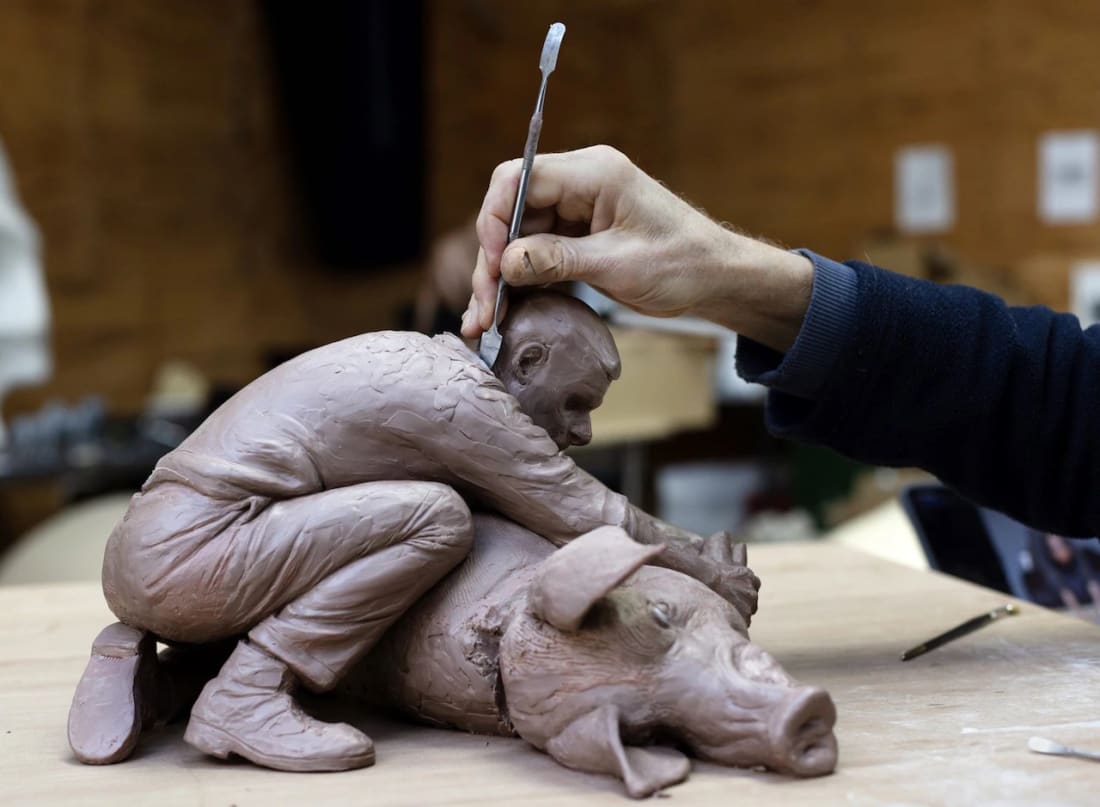Ron Mueck is standing outside the glass-fronted Fondation Cartier in Paris holding up a tiny skull. Inside, a hundred larger skulls – detailed fibreglass replicas, each over a metre tall – are being arranged into a grizzly pile. The 65-year-old Australian is figuring out how to place the last of them on a seemingly precarious stack for a work titled Mass, the centrepiece of a major new exhibition of his art.
Mueck, who became famous in the 1990s among the Young British Artists generation, is known for unsettling, hyper-realistic sculptures that portray the human body with an unflinching gaze, a riposte to the toned abs and pale beauty of classical art. “Ron always seems to capture a character at a key moment in their life,” explains Charlie Clarke, the artist’s longtime studio director. “That might be birth and death, but also scenes that could seem banal, but nonetheless feel as if we’re seeing someone as their world changes. That’s why his work feels so emotionally charged.”
In a second room, Mother and Child will be installed. A piece from the early 2000s, it features a naked woman – at 90cm in length, smaller than life – as she raises her head to look down at the newborn baby lying on her belly, its umbilical cord still intact. The mother’s cheeks are flushed, her body appears to be streaked with sweat but, as is typical of Mueck’s figures, her feelings are hard to read. The baby frowns, staring at its mother as if angry at being brought into the world.
While his peers courted the limelight, Mueck, who came to art from a successful career in cinema as a prop maker and puppeteer (and played the giant Ludo alongside David Bowie in the 1986 fantasy film Labyrinth), rarely grants interviews. I’d been invited to watch him at work with no guarantee he would stop to answer even a single question about his art. “By not talking about it, he makes the viewer bring their own meaning,” says Clarke.
Mueck studiously avoids the Telegraph as the last of the skulls is lowered into place by crane. A red rope has been strung through the eye sockets and around the jaw and it is carefully manipulated by a pair of assistants, each reaching out from cherry pickers, brandishing long poles with what look like pillows strapped to their ends. “A little bit further, rotate it, try getting the cheekbone resting on the jaw below,” Mueck calls out from below.
While this bit of the process involves a team of technicians, for the most part Mueck works alone in his studio on the Isle of Wight. For Mass – first shown in Australia in 2017 – he carved a prototype skull from clay, which was subsequently cast. Then, individual details such as shattered nasal cavities or ruptured ear sockets were added to each skull. “We’ve been very careful to ensure that they have no gender, you don’t know what age the person might have been, what ethnicity, whether they are ancient skulls or modern people,” says Clarke. “Each skull could belong to anyone.”
For earlier projects – Mueck works slowly and has only produced 43 sculptures in his entire three-decade career – the artist used models or photographs to exactly replicate how clothes would hang or skin might blemish with age. He has joked that his male figures often have his own feet and hands, the parts of his body he can easily copy without a mirror.
The Cartier show includes Baby (2000) – a tiny newborn, eyes glistening with tears – and This Little Piggy (2023), in which five men wrestle a sow for slaughter, but it’s another new sculpture, a departure from Mueck’s usual realism, that stands out. In a spotlit space, three huge dogs confront the viewer. Painted a uniform black, they have taut sinews and bared teeth, cast into relief by the harsh lighting. Their legs strain as if to pounce. It is Mueck’s most visceral piece to date. In its shadows, the horror that has long fed into his work feels more muscular than ever.





















































































































































































